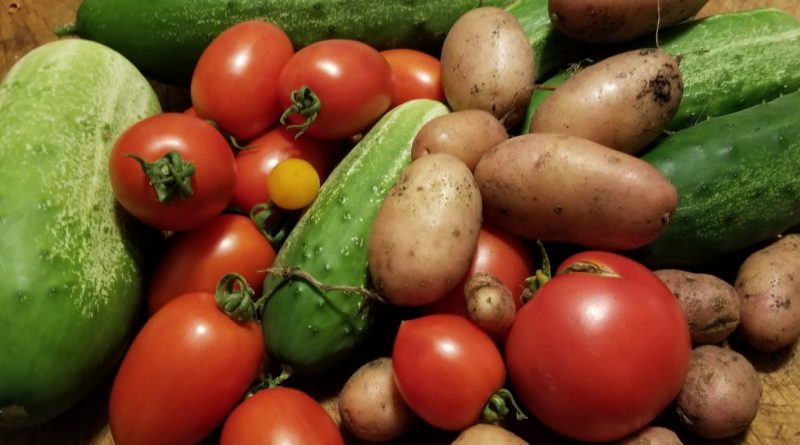Volunteer Your Garden In a Food Crisis
Podcast: Play in new window | Download (Duration: 1:34:02 — 42.5MB)
Subscribe: Apple Podcasts | Spotify | Android | iHeartRadio | Podchaser | Email | TuneIn | RSS | More
(May 3, 2020) A lot of you already grow your own food. That’s a good thing. Today, we’re going to talk about how to volunteer your garden in a food crisis. All that means is growing a little more food. But there’s one more step involved. That’s the part where you donate any excess crops you have to people who desperately need it.
Skip to a specific segment in today’s podcast.
6:59 Gary Oppenheimer from AmpleHarvest.org
54:49 Architect Nathan Kipnis
1:12:43 Meteorologist Rick DiMaio
When we say “desperately,” we’re referring to stories like this from the Chicago Tribune.
Uniformed guardsmen help “take the edge off” at increasingly tense distributions of boxes filled with cans of chicken noodle soup, tuna fish, and pork and beans, said Mike Manning, chief executive at the Greater Baton Rouge Food Bank. “Their presence provides safety for us during distributions,” he added.
Manning, who has worked at the food bank for 16 years, including through Hurricane Katrina, said that he has never witnessed such a combination of need, scarcity and anxiety. “‘Crazy’ pretty much sums it up,” he said.
That was almost a month ago, and I can guarantee that things haven’t gotten better. 30 million Americans have filed for unemployment in the past six weeks. You might have seen videos of lines of cars that snake for miles outside of food pantries. Many of those people have never been in that situation before.
That’s why Gary Oppenheimer returns to our show today. The last time he was with us, a little more than a year ago, some people were food insecure because of a government shutdown. Now, it’s a pandemic, and all on the same watch. Just sayin’. AmpleHarvest.org has a simple mission: to connect home and community gardeners to food pantries across the country. You can do that just by clicking here to find a pantry near you. If you have excess production in your garden, you’re usually a few minutes away from delivering it to one of the 8,700 member food pantries across the United States.
During the COVID-19 crisis, that need is greater than ever. The good news is that Gary’s organization, AmpleHarvest.org, has just teamed with Bonnie Plants. Bonnie Plants is the largest and only national supplier and producer of vegetable and herb plants in the country. This week’s press release states that
Bonnie Plants isn’t just encouraging home gardeners to participate and donate vegetables via AmpleHarvest.org, they’re donating 5% of all plant sales through bonnieplants.com from May 1 through July 31, to AmpleHarvest.org. In addition, Bonnie Plants is leading the charge with donations from their own gardens. Test gardens in Union Springs, Alabama and in Marysville, Ohio have already been repurposed as giving gardens. All of the expected 5,000+ pounds of food grown there will be donated straight to local food pantries in their respective communities.
And that’s how to volunteer your garden. Let’s get started.
How to have a healthy home
It wasn’t all that long ago that Nate Kipnis was on the show. But that was a different world altogether. Which is pretty much the case with any subject these days. Evanston-based Nathan Kipnis, FAIA, is a principal at Kipnis Architecture + Planning. The last time we talked, we were concerned about energy efficiency. Now, the world is concerned about safety. Things change.
And yet, safety and energy efficiency aren’t that much removed from each other. Kipnis recently wrote a piece for the NextHaus Alliance titled Health Begins at Home – Here’s How to Safeguard It. He writes,
Homes have always been havens and sanctuaries. Now, they are also workplaces and learning centers.
As you try to protect the health and wellness of all those who live in your home, did you know that your home can actually protect you? The way a home is designed and constructed can affect its overall sustainability (carbon footprint), resiliency (ability to withstand weather extremes and other harsh elements) and health (prevention or mitigation of health-impacting circumstances).
You should read the whole thing yourself and determine where you fit into the safety conversation. However, here are some areas of note.
- Air Quality. Kipnis notes that “High performance homes require efficient air intake. The outside air is brought in through a high efficiency air-to-air heat exchanger that is combined with a HEPA grade air filter. A HEPA filter removes at least 99.97% of particles that are 0.3 microns in size. An N95 mask, for comparison, only removes at least 95% of 0.3 micron sized particles.
- Water. “A rainwater capture system allows a homeowner to channel water into a barrel for use in irrigation or other non-drinking water uses. There are also gray-water systems that can be installed to recirculate water in your homes in a way that does not contaminate drinking water.”
- Power security. “Reducing reliance on the grid – especially when that grid is stressed – provides peace of mind should conventional power systems go down. Solar photovoltaic panels, when combined with a battery backup system, can provide a portion of a home’s power, generating electricity needed to run critical mechanical systems, water heaters, cooktops and other key devices.”
- Resilient Features. He notes that “Oversized gutters and downspouts are able to keep up with extreme rain events” and “Smart landscaping can absorb intense rains and prevent water pooling around the houses foundation.
That’s just the beginning of the conversation. Volunteer your garden, then volunteer your house in the service of helping the planet. And join us live this morning, or catch the podcast later.



Can’t stress just how deadly this virus is. It’s killing people left and right. Please stay safe everybody!